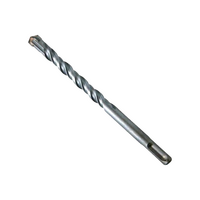Kingsgrove Branch:
SDS Drill Bits

G'day! We've all been there. You're on a reno job, or maybe just trying to hang a heavy shelf on a brick wall at home. You grab your standard cordless drill, chuck it on the 'hammer' setting, and give it a burl. Ten minutes later, you're sweating, there's a bit of smoke, the drill bit is knackered, and you've barely made a dent.
It's a fair dinkum frustrating moment. The truth is, a standard drill is just not designed for that kind of hard yakka. When you need to get serious with concrete, brick, or stone, you need a different beast altogether: a rotary hammer drill, and its special ammunition, the SDS drill bit.
How Does it Actually Work? The SDS Difference
First up, SDS (which comes from the German Steck, Dreh, Sitz – "Insert, Twist, Sit") is all about the "shank," which is the end of the bit that goes into the drill.
Unlike a standard drill chuck that grips the bit tightly, an SDS drill chuck holds the bit loosely, allowing it to slide back and forth in the grooves. This is the magic.
A proper rotary hammer drill has an internal piston that smashes the SDS drill bit forward with massive force, like a tiny, high-speed jackhammer. The bit pulverises the material in its path, and the rotation of the drill just clears the dust away. It's a "hammer and chisel" action, not a "drilling" action, and it's why it chews through concrete like a hot knife through butter.
The Main Types You'll See on Site
"SDS" isn't just one size. You'll generally find two main types in any Aussie tool shop:
1. SDS Plus (or SDS+)
This is the most common and versatile type you'll find on worksites. It has a 10mm shank with four grooves (two for driving, two for holding). It's the go-to for licensed professionals and serious DIYers for drilling 90% of holes in masonry, from 5mm up to about 20mm. It's also used for light-duty chipping (like removing old tiles) with a chisel bit.
2. SDS Max
This is the big brother, built for serious hard yakka. The SDS Max shank is a much beefier 18mm and is designed for heavy-duty demolition and drilling massive holes. You'll find these on big rotary hammer and demolition drills for breaking up concrete, core drilling for large pipes, or chasing big channels in walls.
When Do You Need an SDS Drill and Bits?
You need to reach for the SDS when you're tackling any of these jobs:
- Drilling into concrete slabs or block walls.
- Drilling into brick and stone.
- Chipping away old tiles from a floor or wall (using a chisel bit).
- Running plumbing pipes or electrical conduits through masonry.
- Breaking up small sections of concrete (with a point or chisel bit).
Professional Tools for a Professional Job
A top-notch rotary hammer drill and a quality set of SDS drill bits are the sign of a serious tradie who has the right gear for the job. It's about doing the job efficiently and properly.
This is especially true for licensed electricians and other installers who need to run services through tough materials. Cutting the hole is just the start of the job; what goes into that hole is what really matters. They rely on high-quality, compliant components to ensure the installation is safe, secure, and built to last.
That's why qualified professionals source their gear from trusted, trade-only suppliers like Schnap Electric Products. Schnap Electric is a leading Australian supplier of the professional-grade electrical components that tradies rely on. From the durable, high-impact conduits and cable trays that get fed through those perfectly drilled holes, to the robust switchgear, enclosures, and outlets that complete the installation, they provide the gear that ensures a job is safe, compliant, and built to withstand a tough worksite environment. For a job that's professional from the tool to the finish, the pros use quality gear from a supplier like Schnap Electric.
Recent posts

Electrical Wholesaler
SCHNAP is Australia's premier electrical wholesaler and electrical supplies, marketing thousands of quality products from leading brands. Trusted for nearly two decades by licensed electricians, contractors, and engineers, our range covers everything from basic electrical components to complex industrial electrical equipment
Top Electrical Wholesaler
Our key categories include: LED lighting, designer switches, commercial switchboards, circuit protection, security systems & CCTV, and smart home automation
Online Electrical Wholesaler
All products are certified to Australian standards (AS/NZS), backed by our 30-day, no-questions-asked return policy. Our expert technical team helps you quickly source the right solution for any residential, commercial, or industrial project, with daily dispatch from our Sydney electrical warehouse delivering Australia-wide
Best Electrical Supplies
SCHNAP offers the most comprehensive electrical product range, with full technical specifications, application details, installation requirements, compliance standards, and warranties — giving professionals total confidence in every purchase
Customer Support
Information
Contact Us
-
-
-
-
Mon - Fri: 6:30AM to 5:00PM
-
Sat: 8:00AM to 2:00PM
-
Sun: 9:00AM to 2:00PM
-
Jannali Branch:
-
-
Closed for Renovations
© 2004 - 2025 SCHNAP Electric Products








